BRINGING
UP FATHER AND THE REST OF THE COMIC PAGE
Jiggs
and George McManus
Early comic strips were frequently single-theme enterprises. Their humor resided in little more than a single situation, presented time and time again, each presentation a variation of the first, and basic, situation. We'd call them "one joke" strips in the more sophisticated years in the last decades of the twentieth century, but at the century's beginning, such single-minded thematic choruses, repeated day after day, were awaited eagerly by avid readers. And the themes often proved marvelously adaptable, susceptible of countless mutations. The Katzenjammer Kids with its endless parade of juvenile pranks comes immediately to mind as do others of its turn-of-the-century contemporaries—Foxy Grandpa about a sly oldster turning the tables on youngsters and Her Name Was Maud about a stubborn mule that outwits the humans around her. Such strips were continuous replays of some aspect of the human predicament. They succeeded because the predicament was so fundamental to the human condition and because the attitude towards it that was displayed in the strip was so absolutely refreshing.
One
of the most enduring of these strips was George McManus' masterpiece, Bringing Up Father.
None of us ever called it by its proper name: we called it "Jiggs"
(after its male protagonist) or "Maggie and Jiggs"
(including his wife). And only The
Katzenjammer Kids (which began December 12,
1897) and Gasoline Alley  (November
24, 1918) can claim comparable longevity—112 years for the Katzies, 91 for the Alley; both still
running. The first strip to bear the title Bringing
Up Father appeared on January 2, 1913, a
Thursday. It ran only daily for the next five years (albeit not every
day at first), and then on April 14, 1918, it began appearing in
Sunday format, too. And it ran continuously after that, seven days a
week, until May 28, 2000, when, at the age of 87, it was at last
discontinued (except for some overseas distribution of reprints).
(November
24, 1918) can claim comparable longevity—112 years for the Katzies, 91 for the Alley; both still
running. The first strip to bear the title Bringing
Up Father appeared on January 2, 1913, a
Thursday. It ran only daily for the next five years (albeit not every
day at first), and then on April 14, 1918, it began appearing in
Sunday format, too. And it ran continuously after that, seven days a
week, until May 28, 2000, when, at the age of 87, it was at last
discontinued (except for some overseas distribution of reprints).
But Maggie and Jiggs did not burst upon the comics page fully formed in January 1913. Their origin, in fact, reveals something about the nature of newspaper cartooning in the early decades of the century. Beginning at the Republic in his native St. Louis and then, especially, at the World in New York, McManus had created several comic strips—among them, Nipsy the Newsboy in Funny Fairyland (in imitation of McCay's Nemo) and The Newlyweds, to name a couple. When Hearst recruited the 28-year-old cartoonist in 1912, McManus brought The Newlyweds with him as a Sunday page and retitled it Their Only Child. Then he started cranking up other features for the daily pages.
His first creation for Hearst was Outside the Asylum, a daily strip with no recurring characters that ran for only a month, beginning December 10, 1912. Then came The Whole Blooming Family and Spare Ribs and Gravy and Bringing Up Father. The Jiggs and Maggie strip ran three or four days a week at first, alternating with other domestic comedy titles, Oh! It’s Great To Be Married and Oh! It’s Great To Have a Home and Ah, Yes! That Happy Home, in all of which the husband, after proclaiming his everlasting preference for married life in the opening panels of the strip, discovers a thorn in his bed of roses by the last panel. Meanwhile, on Sundays, McManus created a second page, Love Affairs of a Muttonhead, which accompanied Their Only Child; in tandem, they explored romance and marriage among the young and naive. Later, he also concocted Rosie’s Beau, another examination of romantic relationships, this time, pre-marital. Father, however, focused on the problems a family has in adjusting to their new life in higher society.
In the strip, McManus never explained how Jiggs gained his wealth. In most histories and newspaper accounts over the years, it was said that Jiggs, who had worked as a simple laborer, got rich by winning the Irish Sweepstakes. But not according to McManus, who, in 1920, related Jiggs’ “autobiography” to a newspaper reporter, to wit: Jiggs was born in Ireland. He came to this country expecting to find gold on the streets of New York, but found bricks and cobblestones instead. He became a hod-carrier. Romance came into his life when he met Maggie, a waitress at a small café, who put heaping dishes of corned beef and cabbage before him. They were married, and Jiggs became thrifty. Instead of carrying bricks, he bought and sold them on commission. Then he manufactured them. Street brawls in the old days in New York provided a great market for Jiggs’ bricks, which were harder than ordinary bricks. He grew rich. (In another telling, Jiggs grew rich selling bricks to Ignatz in George Herriman’s strip, Krazy Kat.) At this point in his career Maggie and their daughter Nora acquire social aspirations. And that’s when the trouble began.
Zeke Zekley, McManus’ assistant since the mid-1930s, regaled me with yet another origin of Jiggs’ wealth. McManus told him the story, tongue-in-cheek no doubt. It went like this: When Jiggs was working as a hod-carrier, his employer was another Irishman named Ryan. Ryan liked Jiggs. He liked him so much that he gave Jiggs a dime every time he, Ryan, made a thousand dollars. Ryan got very very rich. And so did Jiggs.
Whatever its source, the family fortune was rather suddenly acquired, catapulting them all forthwith into a social milieu for which they had very little preparation. Jiggs' wife and daughter are socially ambitious and eager to be accepted by the "better people," but Jiggs, wholly unpretentious, perpetually frustrates their parvenu aspirations by behaving as if he's still a hod-carrier on a construction gang. This theme proved the most provocative for McManus' sense of humor: by January 1914, he had discontinued all his daily strips except Father, and by the end of the decade, his other Sunday features were subordinated to Jiggs and Maggie.
McManus was not unique in producing a variety of comic strips for his newspaper. Other early cartoonists did the same, creating features on impulse; some of them lasted only a few days or weeks before giving way to yet another inspiration of the moment. Many of these features appeared as aspects of a sort of daily or weekly anthology of graphic humor. Billy Ireland at the Dispatch in Columbus, Ohio, for instance, did a weekly page called The Passing Show in which he presented a miscellaneous array of panel cartoons on various subjects. Such weekly features were common during the century's first two decades. History tends to remember only those that yielded up long-lived characters. Some of Ireland's Passing Show cartoons featured recurring country characters, the Jedge and Uncle Jerry, but Ireland never felt the urge to produce a cartoon or comic strip about them on a daily basis. Frank King, on the other hand, found his life's work while doing a similar weekly feature, The Rectangle, for the Chicago Tribune during and after World War I, and one of its departments, Gasoline Alley, evolved into a daily strip within a year of its debut. (For the entire history of this remarkable creation, see our celebration of the strip’s 90th anniversary, “Growing Old in Gasoline Alley,” in Harv’s Hindsight for November 2008.)
McManus was also producing an anthology, but his appeared in daily installments, so to speak—a finite variety of aspects of a subject appearing in rotation as a series of individually titled comic strips. But if McManus was in the mainstream of the conventions of newspaper cartooning at the time, he was somewhat unusual in having so focused an anthology. Most such features were genuine hodge-podge collections of comic commentary; McManus concentrated on a single subject.
Although the tack taken in Father was the most distinctive of the domestic situations McManus was experimenting with at the time of its inception, it was nonetheless of-a-piece with his other work. All his strips dealt with relations between the sexes, chiefly marriage. And Jiggs and Maggie were part of the larger ensemble that McManus created in order to explore the human potential for domestic bliss. This exploration had been the principal preoccupation of McManus' career to-date. Not surprisingly, characters resembling Jiggs and Maggie had appeared earlier than 1913 in one or another of the miscellaneous domestic comedy strips that McManus had been doing. According to McManus, the characters who eventually became Jiggs and Maggie first appeared in November 1911. But their personalities were presumably not yet fully formed, nor was the concept for Bringing Up Father well-defined.
Once McManus hit upon the title for his concept, Jiggs and Maggie began to emerge. Their personalities were almost completely articulated by the concept, but McManus hadn't quite settled such matters as their names or their appearance when they debuted. Maggie was called "Mary" in one of the early strips; and Jiggs was spelled "Giggs" at first. (It was used first as a surname although McManus later claimed he didn't know whether it was a first or last name. It was a wholly made-up name, he once said—neither first nor last, “and I don’t know which its owner prefers it to be.” McManus also said the name was intended to invoke the gaiety of the Irish dance.) Their daughter Nora was first called "Katy." McManus was clearly feeling his way. Initially, Maggie's figure was matronly (even a little dumpy). Fairly soon, however, she developed the figure of a chorus girl but retained her painfully plain (even ugly) visage. (McManus described her as "composite of all the beautiful women in the world when they are angry.") With a figure like that, Maggie was the perfect clothes-horse, displaying women's fashions throughout the years. McManus saw to it that she was always dressed in the styles of the moment.
In the beginning, the baboon-faced Jiggs sported a goatee. (And his simian physiognomy partook of a long-standing racial stereotype for the immigrant shanty Irish—a little surprising to the racially sensitive in the closing years of the twentieth century, considering that McManus was himself distinctly Irish.) When he first appeared, Jiggs was almost the same size as his wife, his burly build bespeaking his former career as a hod-carrier. By the mid-twenties, though, he began to grow shorter and wider. Perhaps Maggie was taking her toll, wearing him down. Perhaps, as McManus remarked somewhat in jest, it was due to "the evolving process of creating him in my own image." But there was another reason that McManus gave: "Jiggs is short now for contrast with Maggie. It is simply ridiculous to believe that Maggie could do what she does to a husky, powerful roughneck such as Jiggs was originally." The visual rhetoric of the strip demanded a Jiggs who looked as if Maggie could bully him.
If McManus was still tinkering with the appearance of his characters when Bringing Up Father started, he had no hesitation about his thematic territory. The first half-dozen strips show that he knew his way from the very start. Day after day, Maggie and her daughter are rudely interrupted at their social obligations by the uncouth Jiggs. On the strip's first day, Maggie tells her husband to don formal attire to meet some distinguished guests, but Jiggs has difficulty getting into costume and isn't ready when the guests arrive. After a futile struggle with his tie, he comes to get Maggie to help him. Maggie is just finishing the introductions with her guests when Jiggs wanders into the strip's fourth panel—in shirt-sleeves and stocking-feet (shocking!). His clothes cause consternation again a couple days later when he bursts a suspender button while bowing to meet a visiting count. On his next appearance, Jiggs arrives during one of Maggie's fancy dinners—bringing with him his "old boyhood friend, Bill Maloney," who looks suspiciously like a tramp. Everyone is appalled. The formula was quickly established. Aspiring to acceptance on a higher social plane than she's occupied before, Maggie concentrates on decorum and appearances. The uninhibited Jiggs bursts her bubble the minute he appears. And then comes the crockery.
“It’s slapstick,” McManus acknowledged to Philip Schuyler, an aspiring young cartoonist and reporter, who recorded the cartoonist’s every utterance in a magazine article of September 27, 1924 (of which I have, alas, only an otherwise undocumented clipping). Said McManus: “If you are going to draw comics that sell, you can’t neglect slapstick. The crowd likes old stuff. You must dress it up, however. Put new and different clothes on it. Make it seem swell. There are a lot of people who pretend to be highbrows, who go to a modern so-called high-class show and laugh their heads off at old jokes dressed up. The same jokes may have been used thirty years ago in cheap burlesque, but the different costumes and the gorgeous settings make them funny all over again, and funnier than they ever were before. But your characters must be human. You can exaggerate their personal appearance and the things they do, but to live, they must have background, personal history. They must be human.”
And Jiggs remains wonderfully oblivious to his sinning. Maggie chases him away from the breakfast table because he is still in his undershirt and stocking-feet and she's invited a guest. Jiggs dutifully leaves but returns a few moments later—after the guest has arrived—to retrieve the morning paper he'd left at the table. Maggie and her guest gasp in alarm, and the guest, shocked and insulted, leaves. Jiggs is baffled: "What's the matter? Did she want the paper?" The next day, Maggie asks him to carve the turkey for a diner party. Jiggs takes off his coat and rolls up his sleeves to perform this duty—thereby outraging the guests so much that they all leave. "What's the matter?" he asks Maggie, "—don't they like turkey? I'd rather had corn beef and cabbage, myself."
At first, Maggie reacted to Jiggs' gaucheries by gasping in shock or sputtering in exasperation—or, sometimes, by fainting with fright at the thought of the social humiliation she was sure would follow. But before the end of the inaugural decade, she had adopted her classic tactic: whenever Jiggs strays from the prescribed behavior, she lets him have it with whatever missile was handy. She throws kitchenware and other household furnishings at him. The last panel of many a Father installment is a picture of Jiggs in a blizzard of platters and dishes, a wordless punchline that proclaims the comic conclusion with vaudevillian certainty.
McManus's graphic style evolved to match the ethos of the strip. Deploying a meticulous line of unvarying width, precisely placed, the cartoonist drew clean, uncluttered pictures. No hayey cross-hatching or shading. From this uncomplicated but careful way of rendering, McManus developed the mannered style that characterized his mature work, evidence of which we can see even in the early years in the drapery of the gowns on his female characters. McManus' penmanship was elegant, his line was fine and delicate, and once his style matured (by the early twenties), Father was distinguished by the fine-line detail in ornate backgrounds and Art Deco props—the filigree of a city skyline, the graceful curlicues in the design of a stair-railing or of the pattern in Maggie's dress—and by the judicious and telling placement of solid blacks.
"People frequently mention my sense of design," McManus once remarked, "the little whorls and delicate figures that appear in patterns on Maggie's dresses or in the rooms where she and Jiggs appear. Actually, these are haphazard. I simply begin to doodle—as a fine old artist, whose name I'm sorry I can't remember, taught me to do when I first went to work on the [St. Louis] Republic—and, presently, a pattern appears. I really can't explain why."
Above all else, McManus had a marvelously inventive graphic imagination. The variety of things he drew in his panels—not to mention the copious decorative detail of his work—amuses the eye endlessly (even as it boggles the mind to think of the time and energy he devoted to doing the drawings).And the Sunday pages of Bringing Up Father were often elaborately designed, panels shaped to suit the narrative purpose of the day, their varying sizes and shapes fitting together like jigsaw pieces.
McManus' tricks with silhouette were striking. A silhouette of Jiggs is always accented by the stark white of his shirt collar and cuffs. In silhouette, Maggie frequently stands with the light behind her, which renders her dress nearly transparent, a lacey network of lines, with her figure showing through in silhouette. (At least once, syndicate editors were offended by McManus' daring to reveal Maggie's "superb figure": they filled in the dress, thereby inking the silhouetted figure away. "I think that was being overly proper," McManus said, "but that's the business of the office.") By the thirties, McManus was using Ben-Day shading (a mechanically applied gray tone made with tiny dots) in daily strips, but he also varied the tonal quality of his strip with intricate hachuring and boldly patterned black-and-white designs.
The fecundity of McManus' graphic invention lead him occasionally to play with the form of his medium. Once on a Sunday page in 1938, a wayward character slips in and out of panels, descending the page from tier to tier as if he were scaling the facade of a building from window to window, say, or from ledge to ledge. Another time in a daily strip, Jiggs coils up the "lines" of the panel borders. A similar spirit of playfulness doubtless inspired the antic visual device that McManus originated and that became a sort of trade-mark in Father: he put on the walls pictures in which the resident figures had miniature lives of their own and emerged beyond the picture frames in their antics, sometimes tossing things from one picture to another. "The more burlesque they are, the better," McManus said.
McManus developed the trick accidentally. Once, he said, "when I was drawing a forgotten strip called Ready Money Ladies, I had an annoying problem: there were a couple of figures I wanted to get into a picture frame hanging on the wall, but for balance and design, the frame couldn't be large enough to accommodate them. So I simply drew them outside the frame as well as inside."
The cartoonist met a graphic challenge of a different sort when he took his characters on a tour of the country in 1939-40. The tour took more than a year (dailies as well as Sundays) and so taxed McManus that he once said doing this sequence was "probably the toughest job of my career." He explained: "When it was announced that Jiggs and family were to make the tour, there were demands from everywhere, it seemed, that they visit this or that town. Since it was excellent promotion, I acceded to the demands. The result was that Jiggs and Maggie and Nora went from New York to California via practically every state in the Union and through the Dominion of Canada as well. ... The backgrounds had to be accurate and the work was prodigious."
These tour strips demonstrate McManus' consummate skill as an artist. He was not only skilled: he was passionate about background detail. He said he spent two weeks on a single panel of the Sunday page for December 31, 1939: "This was New Year's Eve," McManus said, "and I had Jiggs looking north in New York's Time Square with the Square faithfully pictured in every detail."
McManus' elegant linework was perfectly matched to his subject. The atmosphere of opulence that pervades the world in which Jiggs and Maggie live was virtually created by the rococo style of McManus' renderings. His graceful line gave substance to artifact and architecture. And the same line was masterful at suggesting a lush female figure with the drapery of fashionable feminine raiment. Jiggs, like any reasonably healthy male animal, was not above ogling pretty girls. (In fact, doing so was perfectly in character for him, contributing to his portrait as an unabashed fellow. But ogle was all he did: no philanderer he.) And McManus made these young women simply gorgeous. He neglected no detail in rendering these beauties: their faces were delicately delineated, their coiffures luxuriously curled and coiled and piled, their figures full, their legs long and curvaceous.
But McManus did not confine himself to drawing the world of the wealthy. Periodically, he produced Sunday pages that reminisced fondly about the life of the laboring classes that Jiggs and Maggie had left behind. Jiggs would lean back and say: "Remember, Maggie me darlin', when we kids used to call at Wun-Lung-Gon, the Chinese laundry, to get your daddy's shirts—I mean, shirt...and how we envied Jerry McGuire when he had the mumps an' didn't have to go to school ... and th' women always had a fancy apron to put on when they answered the front door ... and how cold it used to get in the morning—we used to get the ice-pick to break the ice in the water pitcher so we could wash. ..."
The pictures usually complemented the prose, providing an ironic gloss: "Remember when the boys would go on a fishing trip to get away from the congestion in the city," Jiggs would say—and the picture showed a boat jammed, bow to stern, with fishermen. "Remember, Maggie, the day your mother gave Willie a dime to clean the attic where your father used to take his daily nap—and nip"—and the picture exhibited little Willie contemplating an enormous stack of empty liquor bottles. The comedy was created by the juxtaposition of words and pictures. "And Willie Gitwell tried to show off to Maxie Hazy by smoking a cigar"—and in the picture, Willie is clearly sick. And sometimes the coupling of word and picture yielded a poignant insight into the characters' past: "And how proud you were when I took you up on th' avenue an' we mingled with the elite," Jiggs says, and the picture reveals that at the time, he and Maggie were but seven or eight years old, young lovers indeed (contradicting the story McManus later manufactured of their initial encounter in that small café).
These strips capture the quality and texture of life for immigrants in turn-of-the-century urban America. In them, McManus celebrates communal life along the back alleys of big cities, the numerousness of brothers and sisters and cousins and aunts, the distaste for school among the young, the scarcity of luxuries, the drudgery of the common labor by which they all lived, and the delinquency of fathers (who seemed to spend as much time drunk or in jail—with all their other relatives—as they did on any job). In these strips more than in any other category of his work, McManus' gift for comic art runs rampant, unfettered. His comic figures cavort on these nostalgic pages entirely uninhibited by any purpose other than to be humorous. And that they are. McManus simply “drew funny” as they say in the inky-fingered fraternity. No one could surpass him in portraying the hilarious aspect of an unlettered laborer attired in his Sunday best, celluloid collar choking him to such an extent that his ears stand straight out from his head.
But if these strips deal with the immigrant experience in America directly, they do not embody it as profoundly as does the central theme of McManus' strip. It seems to me that the recurring chorus of Father's formula accurately captures the essence of the immigrant experience—culture shock, all the more disorienting because the rise from rags (metaphorically speaking) to riches (ditto), from the poverty of the Old World to the relative prosperity of the New, was so rapid. The strip epitomized the consequences of this transformation. The inspiration for the strip came to McManus 17 years before he drew it.
Born in St. Louis, Missouri, on January 23 in approximately 1882 or 1883 or, even, 1884 (sources differ, as you can see, wildly, and McManus was never very helpful in resolving the matter, though he mentioned 1884 most often), the son of George McManus, a theater manager, and Kathrine Kenrick, the cartoonist-to-be, like most children, drew pictures as often as he found a pencil in his hand. Unlike most children, he kept on drawing. He was persistent enough to get in trouble. At the tender age of about thirteen, sitting at his desk in school, he drew a picture of a freckle-faced classmate named Sweeney. When his teacher saw the drawing, young George prepared for the worst.
“I expected a whale of a licking,” he told Schuyler. “But apparently she felt my dad could give me a sounder thrashing,” McManus continued, “and so she sent this bit of art with a few others she found in my desk to my father. He was very quiet during supper, and I fancied the strap would get its workout just before bedtime. Instead, he quietly asked: ‘Did you do those?’ I admitted it, and without a word, he went out of the house. The next morning, my father told me to get on my hat and coat and go down to the a local newspaper office, that of the St. Louis Republic, to work. He had brought Sweeney to show the editor, and it made a hit. I worked for a year at $5 a week, and then was given a dollar raise.”
McManus started in the paper’s art department—sweeping the floor and running errands. But he eventually worked himself into a staff artist situation, trailing behind reporters to sketch train wrecks, trials, murder scenes, “jilted Jezebels,” hangings and suicides. McManus said he attended 120 hangings in the courtyard of the city jail, claiming it was a national record. Wearying of his gruesome assignments, he started drawing cartoons for the paper in unassigned hours. His first comic strip, Elmer and Oliver (or perhaps Alma and Oliver), McManus once described as “mercifully forgotten.”
His departure from St. Louis for the Big Time is as fabled as his induction into the newspaper business. In 1903, acting on a bootblack's tip, McManus bet $100 on a horse named Hamburg Belle running 30-to-1 in the Futurity Stakes at Belmont Park, and when the nag won, McManus used the money to go to New York, where he spend several months, according to The Newsweek in the Fourth Estate in 1935, “swizzling beer in the city’s ornate bars” and sometimes looking for a job. Eventually, having run through his stash and poised in the cusp of starvation, McManus got two job offers on the same day: one from the McClure Syndicate, the other from Joseph Pulitizer’s New York World. The World would pay less, but McManus took that job thinking his cartoons would be simultaneously published in Pulitzer’s other newspaper, the St. Louis Post-Dispatch, and everyone in his erstwhile hometown would know he was making good.
As a staff cartoonist, McManus produced a considerable share of his paper's cartoon artwork. He drew several short-lived comic strips—Snoozer, The Merry Marceline, Ready Money Ladies, Cheerful Charlie, Panhandle Pete, Let George Do It, Nibsy the Newsboy in Funny Fairyland, sometimes filling most of the Sunday edition with his work—and then hit his stride in 1904 with The Newlyweds, a novel enough conceit to attract the attention of Pulitzer's adversary in the city's celebrated circulation war, William R. Hearst, who, as was his custom, lured McManus to his Journal American in 1912 with an offer of higher remuneration. McManus brought The Newlyweds with him as a Sunday page, its comedy perhaps sustained, by this time, through experience: McManus married a concert singer named Florence Bergere on December 24, 1910. McManus retitled the strip Their Only Child while he and Florence remained childless their entire life-long marriage. But marriage, as we’ve seen, remained his subject—that and the eternal clash between pretense and authenticity.
Growing up in St. Louis, young George saw a play in 1895 in the theater his father managed. The play, “The Rising Generation,” featured a poker game scene, during which, for 20 minutes each night, the actors played a real game of poker for real stakes and ad-libbed throughout. One of the poker players, the hero of the piece, Martin McShayne (played by the Irish comedian William Barry in the production McManus witnessed), was a little Irish laborer who'd struck it rich and moved to Fifth Avenue. As McManus tells it: "His socially ambitious wife and daughter were ashamed of his uninhibited naturalness and they could not abide his old pals (left-overs from the days before he was rich). Therefore, he had to sneak off to the poker game, which was in the back room of a saloon run by an old friend in the district from which the Irisher came."
In the Irish poker player's "uninhibited naturalness" and in his consequent unflagging desire to escape (for however brief a time) from the pretensions of the social world into which his wealth has flung him, we find the quintessential Jiggs—and the formula that is central to most of the humor in Bringing Up Father as well as the theme of the immigrant experience in America. Although the formula involves but a single, basic situation which was expressed in only about a dozen different ways, McManus multiplied that 1-times-12 to produce an infinite number of variations upon his basic theme. Each of those modifications restates the central conflict of the informing formula, the moral implications of the culture clash that ensues when ordinary people try to be something they are not.
Jiggs' abiding affection for a game of cards, a drink, the fellowship of his old cronies at Dinty Moore's corner saloon, for corned beef and cabbage (the strip's ubiquitous symbol of a simpler more natural life), and for pretty girls pits him forever against Maggie's tyrannical efforts to reform him, to mold him into a dignified shape appropriate to their new status and to her social ambitions. As often as not, Maggie is defeated in her efforts by her own bad taste or by her fundamental ignorance of the ways of high society. By far the bulk of Bringing Up Father deals with situations that exemplify these traits in Jiggs or Maggie. In the forty-one years he drew Father before he died in 1954, McManus never entirely abandoned his "single situation" formula. It faded into the background for one or two strips, but it soon emerged again, an unending restatement of the strip's enduring theme. In this regard, McManus carried far into the twentieth century the essential character of the early comic strip.
Because Father presents so often the situation that embodies its basic theme, the daily strips frequently seemed to end without a punchline. That impression is due partly to the fact that we've seen that punchline—that situation itself—before. But even if we hadn't, we don't really need a punchline. The situation itself is the mainspring of the humor in the strip—not any punchline at the end. Given a ready-made comic conclusion of this sort in the very situations he depicted, McManus developed the humor in a given installment by weaving witty repartee into its panels throughout. The kind of humor we have come to associate with the last panel of a humor strip we often found in the first, second, or third panels of Father. Here's a sample bit of dialogue from the first panel of a 1939 strip:
Nora (in a riding costume): Why, Daddy—this is my English riding habit. I intend to wear it a great deal when I get to England.
Jiggs: I hope I don't form any habits like that. It looks like a fit to me.
This
strip concludes when Jiggs sees Maggie in her version of the same
English riding costume. And the visual nature of the medium creates
the final punchline.  Nora looks beautiful and dignified in her
costume, but that's because she's beautiful and dignified looking—not
because the costume contributes anything. Jiggs sees the costume; we
see the costume and the girl. On Maggie, who hasn't the saving grace
of physical beauty, we see the riding costume as Jiggs saw it on
Nora: as an outlandish and therefore ridiculous outer covering.
Maggie puts on the costume in the simple, misguided belief that
appearances are all: her clothes will prove she belongs in English
high society. To assure the success of the effort, she's added a
monocle. It is the appearance of status, to be sure. But Jiggs knows
Maggie—and Nora—and the nature of their origins, who they
really are and what. In his startled reaction when he sees Maggie, we
find the hint that clothes do not, despite appearances, make the man.
Or the woman. Maggie is wrong again: she falls short of her
pretentious ambitions.
Nora looks beautiful and dignified in her
costume, but that's because she's beautiful and dignified looking—not
because the costume contributes anything. Jiggs sees the costume; we
see the costume and the girl. On Maggie, who hasn't the saving grace
of physical beauty, we see the riding costume as Jiggs saw it on
Nora: as an outlandish and therefore ridiculous outer covering.
Maggie puts on the costume in the simple, misguided belief that
appearances are all: her clothes will prove she belongs in English
high society. To assure the success of the effort, she's added a
monocle. It is the appearance of status, to be sure. But Jiggs knows
Maggie—and Nora—and the nature of their origins, who they
really are and what. In his startled reaction when he sees Maggie, we
find the hint that clothes do not, despite appearances, make the man.
Or the woman. Maggie is wrong again: she falls short of her
pretentious ambitions.
Here's another dialogue sample; this time, from 1919:
Maggie (who is thinking of her birthday being tomorrow): Do you know what day tomorrow is?
Jiggs: Sure—it's Dugan's chowder party. Kin I go?
Maggie: You insect. I married you to reform you.
Jiggs: You've succeeded: I'll never marry again.
Maggie: I wish I'd never met you.
Jiggs: Yes—now when it's too late, you are sorry for me.
There are at least two good punchlines in the foregoing—and we haven't come to the strip's last panel yet. In that last panel, Jiggs is seen in a hail of crockery, Maggie's customary corrective for his unrepentant uninhibitedness. We've seen it before, and we'll see it again: the punchline is built into the situation, and, seemingly, we never tired of seeing that situation replayed.
Jiggs' unceasing attempts to escape from Maggie's world to Dinty Moore's were given heroic dimension by McManus. Throughout the years, he demonstrated convincingly that Jiggs would do anything to escape, resort to any device, follow any route. In the classic Sunday routine, Maggie locks Jiggs in his room, and he leaves by an upper story window, creeps along the cornice twenty stories above the ground to a telephone wire, walks the wire, swings to a steel girder suspended high above the street, and finally gets lowered to a convenient back alley from which it is but a few steps to Dinty's tavern and the goodly fellowship he craves. The pictures create the comedy as well as the illusion upon which the comedy depends: we laugh because the extremes to which Jiggs resorts are so outlandish, so exaggerated, and yet we believe it is happening because we can see it with our own eyes, right there before us on the page.
After witnessing a performance or two like this, readers could reasonably be expected to be bored by further repetition of the maneuver, the humor in it exhausted. Not so. Jiggs did all these things countless times for over forty years, and he kept his readers with him all the way. By the time McManus died, Jiggs was repeating his escape act in 500 newspapers in 46 countries—an estimated audience of 80 million people. The inexhaustible humor in the situation lay in Jiggs' marvelous ingenuity—and that, in turn, spoke of the unquenchable resourcefulness of human aspiration. But it is in the nature of that aspiration—in its fundamental message—that we find the basic, unyielding appeal of the strip.
In Jiggs' unrelenting effort to escape and in Maggie's frequent failure to live up to her own pretensions, we see the seemingly endless elaboration on the theme that people will be themselves—and that they are the better for so being, regardless of social pretensions. It was, for countless immigrants, the message of America. In one of the oft-repeated reversals found in Bringing Up Father, Maggie discovers that Jiggs is already the intimate companion of some social lion whom she wanted him to meet. And Jiggs has done it by being himself.
In later years, McManus recognized explicitly the simple message of his strip. In an article in Collier's (from which I've been quoting him), McManus wrote: "My own conclusion is that Jiggs and Maggie are burlesques of basic human characteristics. I say 'conclusion' because only in relatively recent years have I thought much about it. Most of the time, I just drew characters I thought were amusing in situations I thought were funny. It was as simple as that. ... Jiggs represents man's eternal struggle to be himself in this modern world. Always he strives against what he considers feminine domination and a womanly desire to mold him into an ideal image. His resistance is constant, but so are his respect and tolerance, so he usually fights back obliquely.”
In 1931, MacManus moved to Santa Monica, California, for his wife's health; she remained an invalid most of their married life. MacManus died in Santa Monica of hepatitis; the strip was continued by others, none of whom could quite capture the essential Jiggs in the manner of McManus and his long-time assistant Zekley. Bringing Up Father was the first American comic strip to achieve worldwide fame: during its heyday, its creator was probably the highest paid cartoonist on the planet.
A convivial short, heavy-set man who consumed cigars at the rate of three dozen a day, MacManus was often assumed to be himself the model for Jiggs. The cartoonist acknowledged similarities: "Jiggs and I enjoy being ourselves. Hedda Hopper wrote once that I draw Jiggs the way I want to be myself. Maybe. Anyway, we both like people. We like restaurants and round tables, with people sitting around them enjoying themselves."
MacManus
might have been summarizing the appeal of his strip. It was about
people enjoying themselves by being themselves, a message MacManus
dinned into his readers for nearly two generations in a vivid
demonstration of the power of the single-situation comedy that so
often characterized early comic strips. Now here’s a gallery of
Jiggs.
 |
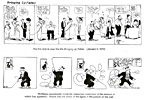 |
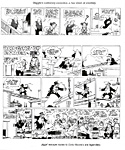 |
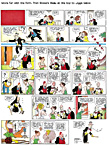 |
 |
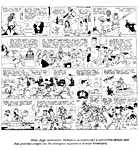 |
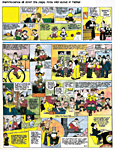 |
 |
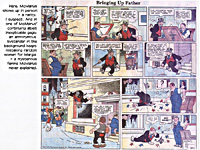 |
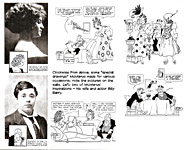 |
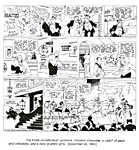 |
Bibliography. The foregoing appreciation of Bringing Up Father is based upon a chapter in a book of mine, The Art of the Funnies, to which I’ve added information recently uncovered in the course of My Vast and Unending Researches. (You can preview the book here.) The only readily-available biographical information on George MacManus is contained in a three-part article he wrote with Henry La Cossit for Collier's in 1952, "Jiggs and I," which appeared in the issues for January 19 (pp. 9-11, 66-67), January 26 (pp. 24-25, 67-69), and February 2 (pp. 30-31, 39, 41). The first year of Bringing Up Father is reprinted in a volume of that title by Hyperion Press (1977), with a useful Introduction by Bill Blackbeard; the first two years in NBM’s Classic Screwball Strips series, George McManus’s Bringing Up Father (2009), with a Foreword by Blackbeard and an Introduction by Yrs Trly, plus copious explanatory footnotes by Allan Holtz. A sampling of Sunday pages in color can be found in Jiggs Is Back (1986), and a representative selection from the entire run of the strip (albeit with an emphasis on the vintage years of the 1930s and 1940s) is contained, albeit badly reproduced, in Bringing Up Father by George MacManus (1973; edited by Herb Galewitz). The famed cross-country trip (January 2, 1939-July 7, 1940) is reprinted in IDW’s Bringing Up Father: From Sea to Shining Sea, Volume 1 (2009).
